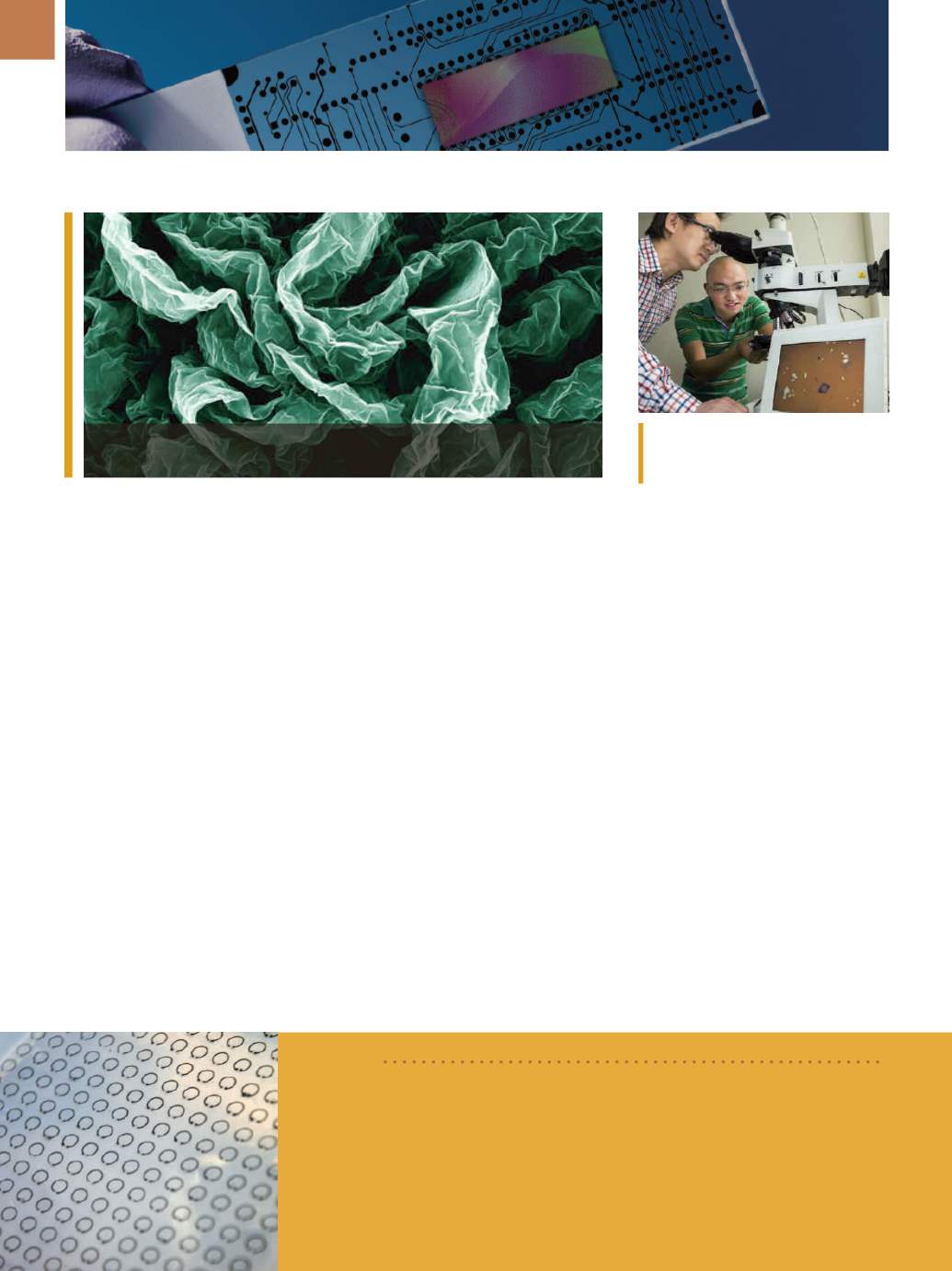

A D V A N C E D M A T E R I A L S & P R O C E S S E S | M A Y 2 0 1 6
2 0
NANOTECHNOLOGY
ENHANCING GRAPHENE
WITH WRINKLES
Engineers at Brown University,
Providence, R.I., show that graphene,
wrinkled and crumpled in a multistep
process, becomes significantly better at
repelling water. Researchers deposited
graphene oxide in layers onto shrink
films. As the films shrink, the graphene
on top is compressed, causing it towrin-
kle. Researchers experimented with dif-
ferent configurations in the successive
generations of shrinking. For example,
sometimes they clamped opposite
ends of the films, which caused them
to shrink only along one axis. Clamped
films yielded graphene sheets with peri-
odic, nearly parallel wrinkles across its
surface. Unclamped films shrank in two
dimensions, both length- and width-
wise, creating a graphene surface that
was crumpled in random shapes.
A highly crumpled graphene sur-
face becomes superhydrophobic with
three unclamped shrinks. Crumpling
also enhances graphene’s electrochem-
ical behaviors, which could be useful
in next-generation energy storage and
generation. Crumpled graphene used
as a battery electrode has as much
as a 400% increase in electrochemi-
cal current density over flat graphene
sheets, significantly boosting efficiency.
brown.edu.
THIN LENS SEES FUTURE
IN MINIATURE CAMERAS
Scientists created the world’s
thinnest lens, one two-thousandth the
thickness of a human hair, opening
the door to flexible computer displays
and a revolution in miniature cameras.
“This type of material is the perfect can-
didate for future flexible displays,” says
Yuerui Lu of the Australian National Uni-
versity Research School of Engineering.
“We will also be able to use arrays of
micro lenses to mimic the compound
eyes of insects.”
The 6.3-nm lens outshines pre-
vious ultrathin flat lenses, made from
Larry Lu (left) and Jiong Yang with lens
shown on screen. Courtesy of Stuart
Hay/ANU.
BRIEF
Engineers at
Iowa State University,
Ames, developed a flexible, stretchable, and
tunable
meta-skin
that uses rows of small, liquid-metal devices to cloak an object
from the sharp eyes of radar. By stretching and flexing the polymer skin, it can be
tuned to reduce the reflection of a wide range of radar frequencies.
iastate.edu.
Meta-skin developed at Iowa State University. Courtesy of Liang Dong.
50-nm thick gold nanobar arrays,
known as a metamaterial. Molybde-
num disulphide is in a class of materi-
als known as chalcogenide glasses that
have flexible electronic characteristics,
which have made them popular for
high-tech components. The team cre-
ated their lens from a crystal 6.3-nm
thick, which they peeled off a larger
piece of molybdenum disulphide with
sticky tape. They then created a 10-
μ
m
radius lens, using a focused ion beam
to shave off layers atom by atom, until
they had the dome shape of the lens.
The team discovered that sin-
gle layers of molybdenum disulphide,
0.7 nm thick, have remarkable optical
properties, appearing to a light beam
to be 50 times thicker, at 38 nm. This
property, known as optical path length,
determines the phase of the light and
governs interference and diffraction of
light as it propagates.
For more informa-
tion: Yuerui (Larry) Lu, 61.2.612.59582,
yuerui.lu@anu.edu.au,
www.anu.edu.au.
Wrinkles and crumples, introduced by placing graphene on shrinky polymers, can
enhance graphene’s properties. Courtesy of Hurt and Wong Labs/Brown University.


















